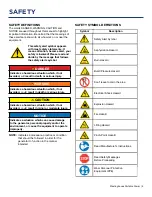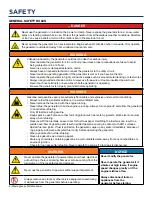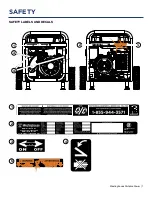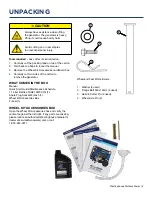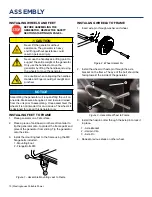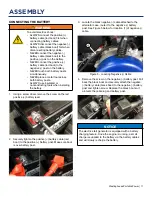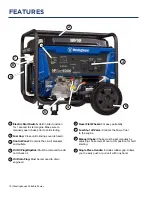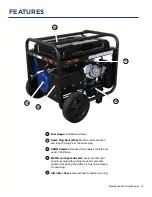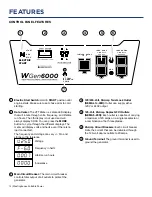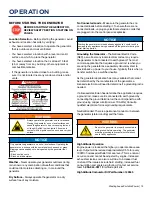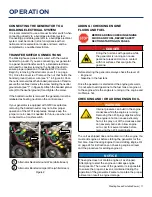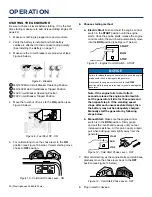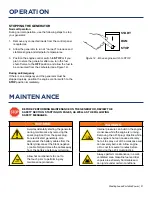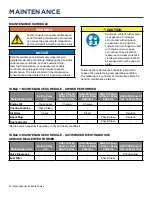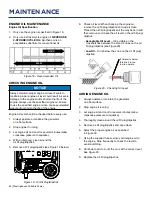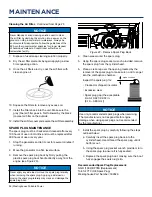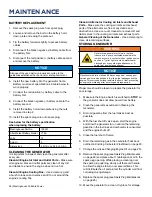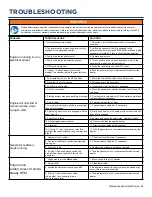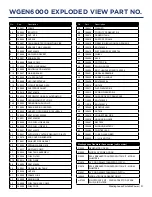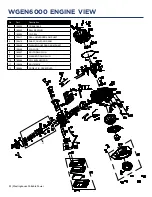
Westinghouse Portable Power | 19
OPERATION
POWER OUTPUT AND DEMAND
The generator should not be run completely unloaded for extended periods otherwise the engine may be
damaged. It is recommended that the generator should always be operated with at least one-third of its
rated 120-Volt AC power output. 120-Volt AC devices have two different electric power demands that must
be taken into consideration, namely the running power and the starting/peak power. Both are measured in
Watts (typically abbreviated as “W”).
The steady state continuous load is the running power demand and this is often marked on the device near
its model number or serial number. Sometimes the device might only be marked with its voltage (i.e. 120 V)
and current draw (e.g. 6 Amp or 6 A), in which case the running power demand in Watts can be obtained by
multiplying the voltage times the current, e.g. 120 V × 20 A = 2,400 W.
Simple resistive 120-Volt AC devices such as incandescent bulbs, toasters, heaters, etc. have no extra power
demand when starting, and so their starting power demands are the same as their running power demands.
More complex 120-Volt AC devices containing inductive or capacitive elements such as electric motors have a
momentary extra power demand when starting, which can be up to seven times the running power demand or
more. Manufacturers of such devices rarely publish this starting power demand and so it’s often necessary to
estimate it. A rule of thumb for devices fitted with an electric motor is to apply a starting power multiplier of 1.2
for small hand-held or portable devices and a value of 3.5 for larger stationary devices. For example, a 900 W
angle grinder can be assumed to have a starting power demand of at least 1.2 × 900 W, which equals 1,080 W.
Similarly, a 1,650 W air compressor can be assumed to have a starting power demand of at least 3.5 × 1,650 W,
which equals 5,775 W.
To prevent overloading of the generator’s 120-Volt AC system:
1.
Add up the running power demand of all the 120-Volt AC devices that will be connected to the generator at
one time. This total must not be greater than the generator’s specified running power output.
2.
Add up the running power demand again, but for the largest motor-driven device use the value of its starting
power demand instead of its running power demand. This total must not be greater than the generator’s
specified starting power output.
3.
The total running power demand of all the devices that will be connected to any one of the generator’s
outlets must not exceed the generator’s specified running power output or 3,700 W, whichever is the lesser.
Summary of Contents for WGen6000
Page 1: ...USER MANUAL WGen6000 Portable Generator 6000 Running Watts 7500 Peak Watts...
Page 8: ...8 Westinghouse Portable Power SAFETY SAFETY LABELS AND DECALS 8 7 10 8 9 6 6 7 5 10 9...
Page 30: ...30 Westinghouse Portable Power WGEN6000 EXPLODED VIEW...
Page 34: ...34 Westinghouse Portable Power WGEN6000 SCHEMATIC WH7500v SCHEMATIC...
Page 36: ...36 Westinghouse Portable Power Version 08 10 18KD...

